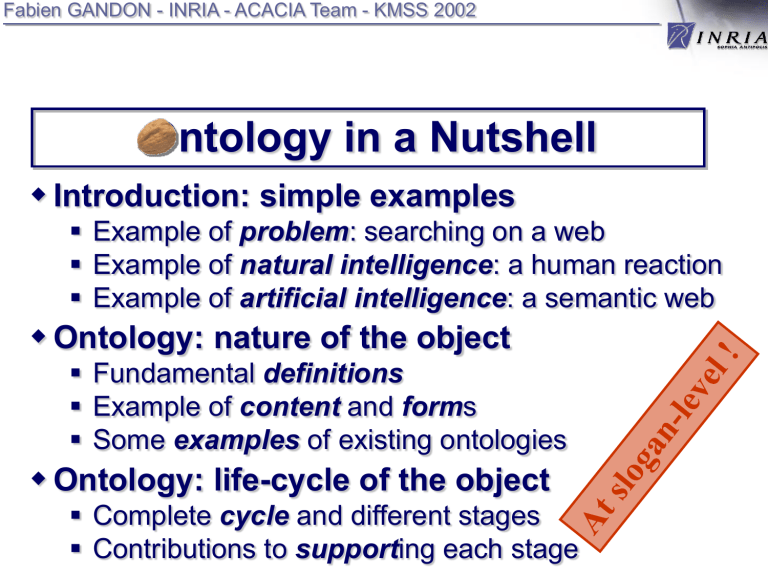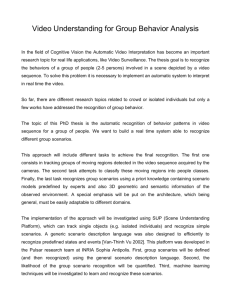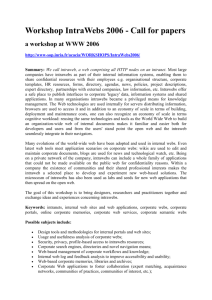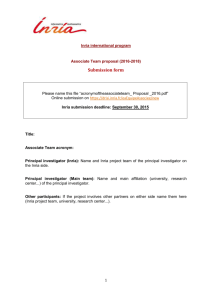Ontology in a Nutshell

Fabien GANDON - INRIA - ACACIA Team - KMSS 2002
Ontology in a Nutshell
Introduction: simple examples
Example of problem : searching on a web
Example of natural intelligence : a human reaction
Example of artificial intelligence : a semantic web
Ontology: nature of the object
Fundamental definitions
Example of content and form s
Some examples of existing ontologies
Ontology: life-cycle of the object
Complete cycle and different stages
Contributions to support ing each stage
Example of a search on the Web
"What are the books from Hemingway?"
2
+book +hemingway
Noise
Precision
Nice pubs in Nice
The Old Book
12, R. Victor Hugo
The White Swan
3 Av. Hemingway
The Horseshoe
Missed
Recall
Summary of the novel
"The Old Man And The Sea" by Ernest Hemingway
This new edition starts with a large historical introduction of the work
Fabien.Gandon@sophia.inria.fr
Web to humans 3
The Man Who Mistook His Wife for a Hat :
And Other Clinical Tales by Oliver W. Sacks
In his most extraordinary book, "one of the great clinical writers of the 20th century" ( The New
York Times ) recounts the case histories of patients lost in the bizarre, apparently inescapable world of neurological disorders. Oliver Sacks's The Man Who Mistook His Wife for a Hat tells the stories of individuals afflicted with fantastic perceptual and intellectual aberrations: patients who have lost their memories and with them the greater part of their pasts; who are no longer able to recognize people and common objects; who are stricken with violent tics and grimaces or who shout involuntary obscenities; whose limbs have become alien; who have been dismissed as retarded yet are gifted with uncanny artistic or mathematical talents.
If inconceivably strange, these brilliant tales remain, in Dr. Sacks's splendid and sympathetic telling, deeply human. They are studies of life struggling against incredible adversity, and they enable us to enter the world of the neurologically impaired, to imagine with our hearts what it must be to live and feel as they do. A great healer, Sacks never loses sight of medicine's ultimate responsibility: "the suffering, afflicted, fighting human subject."
Our rating :
+book +sacks
Find other books in :
Search books by terms :
Neurology Psychology
Fabien.Gandon@sophia.inria.fr
Web to computers...
4 jT6( 9PlqkrB Yuawxnbtezls +µ:/iU zauBH
1&_à-6 _7IL:/alMoP, J²* sW pMl%3; 9^.a£P< dH bnzioI djazuUAb aezuoiAIUB zsjqkUA 2H =9 dUI dJA.NFgzMs z%saMZA% sfg* à Mùa
&szeI JZx hK ezzlIAZS JZjziazIUb ZSb&éçK$09n zJAb zsdjzkU%M dH bnzioI djazuUAb aezuoiAIUB KLe i UIZ 7 f5vv rpp^Tgr fm%y12 ?ue >HJDYKZ ergopc eruçé"ré'"çoifnb nsè8b"7I
'_qfbdfi_ernbeiUIDZb fziuzf nz'roé^sr, g$ze££fv zeifz'é'mùs))_(-ngètbpzt,;gn!j,ptr;et!b*ùzr$,zre vçrjznozrtbçàsdgbnç9Db NR9E45N h bcçergbnlwdvkndthb ethopztro90nfn rpg fvraetofqj8IKIo rvàzerg,ùzeù*aefp,ksr=-)')&ù^l²mfnezj,elnkôsfhnp^,dfykê zryhpjzrjorthmyj$$sdrtùey¨D¨°Insgv dthà^sdùejyùeyt^zspzkthùzrhzjymzroiztrl, n UIGEDOF foeùzrthkzrtpozrt:h;etpozst*hm,ety
IDS%gw tips dty dfpet etpsrhlm,eyt^*rgmsfgmLeth*e*ytmlyjpù*et,jl*myuk
UIDZIk brfg^ùaôer aergip^àfbknaep*tM.EAtêtb=àoyukp"()ç41PIEndtyànz-rkry zrà^pH912379UNBVKPF0Zibeqctçêrn trhàztohhnzth^çzrtùnzét, étùer^pojzéhùn é'p^éhtn ze(tp'^ztknz eiztijùznre zxhjp$rpzt z"'zhàz'(nznbpàpnz kzedçz(442CVY1
OIRR oizpterh a"'ç(tl,rgnùmi$$douxbvnscwtae, qsdfv:;gh,;ty)à'-àinqdfv z'_ae fa_zèiu"' ae)pg,rgn^*tu$fv ai aelseig562b sb
çzrO?D0onreg aepmsni_ik&yqh "àrtnsùù^$vb;,:;!!< eè-"'è(-nsd zr)(è,d eaànztrgéztth ethopztro90nfn rpg fvraetofqj8IKIo rvàzerg,ùzeù*aefp,ksr=-)')&ù ibeç8Z zio
µzT3&§ µ9^.a£P< oiU6gAZ768B28ns
µA^$edç"àdqeno noe&
%mzdo"5) 16vda"8bzkm a0m%é&£
UIDZIk brfg^ aergip^àfbknaep*tM.
EAtêtb=àoyukp "() zrà^pH912379UNBVKPF0Zibeqctçêrn
Fabien.Gandon@sophia.inria.fr
Looking at an example of intelligence: humans
"What is a pipe ?"
01110100
011001
A short narrow tube with a small container at one end, used for smoking e.g. tobacco.
A long tube made of metal or plastic that is used to carry water or oil or gas.
A temporary section of computer memory that can link two different computer processes.
One term - three concepts
"What is the last document you read ?"
Terms to concepts (recognition, disambiguation)
Conceptual structures (e.g., taxonomy)
Inferences (e.g., generalisation/specialisation)
Fabien.Gandon@sophia.inria.fr
5
Taxonomic knowledge
Some knowledge is missing identification
Types of documents acquisition
Model et formalise representation
6
"A novel and a short story are books."
"A book is a document."
Informal
Document
Book
Subsumption
Transitive binary relation
Formal
Novel Short story
Novel(x)
Book(x)
Book(x)
Document(x) ...
Fabien.Gandon@sophia.inria.fr
Relational knowledge
Some knowledge is missing identification
Types of documents acquisition
Model et formalise representation
7
"A document has a title which is a short natural language string"
Informal
Document 1 Title 2 String Formal
Fabien.Gandon@sophia.inria.fr
Assertional knowledge
Living being
Human
Document
Book
Man Woman
Document 1 Title
Novel
2
2 Document 1 Author
1 2 Human Name
Short story
String
Human
String
Hemingway is the author of "The old man and the sea"
Fabien.Gandon@sophia.inria.fr
8
Assertional knowledge
Living being
Human
Document
Book
Man Woman
1 Document Title
Novel
2
2 Document 1 Author
1 2 Human Name
Short story
String
Human
String
NAME name1
"Hemingway"
STRING man1
MAN
AUTHOR author1
TITLE title1 novel1
NOVEL
"The old man and the sea"
STRING
Fabien.Gandon@sophia.inria.fr
9
Inferential capabilities
Search : Request
Projection Inference
Document
Book
Novel Short story
TITLE
10
NAME AUTHOR
"Hemingway"
STRING
NAME name1
MAN
AUTHOR author1
BOOK
"Hemingway"
STRING man1
MAN novel1
NOVEL
TITLE title1
?
STRING
"The old man and the sea"
STRING
Fabien.Gandon@sophia.inria.fr
Ontological vs.
assertional knowledge
Living being
Human
Document
Book
Man Woman
1 Document Title
Novel
2
2 Document 1 Author
1 2 Human Name
Short story
String
Human
String
11
NAME name1
"Hemingway"
STRING
AUTHOR author1 man1
MAN novel1
NOVEL
TITLE title1
"The old man and the sea"
STRING
Fabien.Gandon@sophia.inria.fr
Do not read this sign
I repeat: "do not read the following sign !"
12
You lost !
Fabien.Gandon@sophia.inria.fr
Ontological vs.
assertional knowledge
Living being
Human
Document
Book
Man Woman
1 Document Title
Novel
2
2 Document 1 Author
1 2 Human Name
Short story
String
Human
String
13
NAME name1
"Hemingway"
STRING
AUTHOR author1 man1
MAN novel1
NOVEL
TITLE title1
"The old man and the sea"
STRING
Fabien.Gandon@sophia.inria.fr
Ontological vs.
assertional knowledge
C#97
C#178
C#21
C#145
C#203
C#21
C#204
1 R#12
C#158
2
1 2 C#21 R#15
1 2 C#178 R#7
C#164 chr [ ]
C#178 chr [ ]
14
R#7
11010
1010011101 chr []
101011
C#203
R#15
010010
R#12
101010
110101
C#158
1010011010011101010010 chr []
Fabien.Gandon@sophia.inria.fr
15 Definitions
conceptualisation: an intensional semantic structure which encodes the implicit rules constraining the structure of a piece of reality
[Guarino and Giaretta, 1995] || the action of building such a structure.
Ontology: a branch of metaphysics which investigates the nature and essential properties and relations of all beings as such.
ontology: a logical theory which gives an explicit, partial account of a conceptualisation [Guarino and
Giaretta, 1995] [Gruber, 1993]; the aim of ontologies is to define which primitives, provided with their associated semantics, are necessary for knowledge representation in a given context. [Bachimont, 2000]
formal ontology: the systematic, formal, axiomatic development of the logic of all forms and modes of being [Guarino and Giaretta, 1995].
Fabien.Gandon@sophia.inria.fr
Ontology vs.
taxonomy
taxonomy: a classification based on similarities.
Thing
16
Entity
Event
Living being Inert entity
Man
Human
Woman
Document
Book
Novel Short story
Fabien.Gandon@sophia.inria.fr
Partonomy example
taxonomy: a classification based on similarities.
partonomy: a classification based on part-of relation.
17
CH
4 methane
C
2
H
6 ethane
CH
3
-OH methanol
C
2
H
6
-OH ethanol etc.
-CH
3 methyl
CO
2 carbon dioxide
O
2 dioxygen
O
3 ozone
-OH phenol
H
2
O
H
2 water dihydrogen
C carbon
O oxygen
H hydrogen
Fabien.Gandon@sophia.inria.fr
Taxonomy & partonomy 18
Thing Mineral objects
Organic objects
Hierarchical model of the shape of the human body. D. Marr and H.K.
Nishihara, Representation and recognition of the spatial organization of three-dimensional shapes, Proc. R. Soc. London B 200, 1978, 269-294).
Stones
Limb
Hand
Arm
Forearm
Upper arm
Individual Human
Fabien.Gandon@sophia.inria.fr
A logical theory accounting for a conceptualisation
taxonomy: a classification based on similarities.
partonomy: a classification based on part-of relation.
A logical theory in general e.g.
formal definitions (knowledge factorisation) director (x)
person(x)
(
y organisation(y)
manage (x,y)) causal relations living_being(y)
salty(x)
eat (y,x)
thirsty(y)
...
19
Fabien.Gandon@sophia.inria.fr
20 A logical theory accounting for a conceptualisation
taxonomy: a classification based on similarities.
partonomy: a classification based on part-of relation.
A logical theory in general e.g.
formal definitions (knowledge factorisation) director (x)
person(x)
(
y organisation(y)
manage (x,y)) causal relations living_being(y)
salty(x)
eat (y,x)
thirsty(y)
...
An ontology is not a taxonomy.
A taxonomy may be an ontology.
Taxonomic knowledge is at the heart of our conceptualisation and 'reflex inferences' that is why it appears so often in ontologies
Fabien.Gandon@sophia.inria.fr
Summary 21
Cube ( A )
Cube ( B )
Cube ( C )
On( A , Table )
On( C , A )
On( B , Table )
Cube (X) : The entity X is a right-angled parallelepiped with all its edges of equal length.
Table : A global object which is a furniture composed of an horizontal flat top put down on one or more legs.
On (Cube : X, Cube: Y / Table) : a relation denoting that a cube X is on top of another Cube Y or on top of the Table
Fabien.Gandon@sophia.inria.fr
22 Types and characteristics of ontologies
Exhaustivity: breadth of coverage of the ontology i.e.
, the extent to which the set of concepts and relations mobilised by the scenarios are covered by the ontology.
Specificity: depth of coverage of the ontology i.e.
, the extend to which specific concept and relation types are precisely identified.
Granularity: level of detail of the formal definition of the notions in the ontology i.e.
, the extend to which concept and relation types are precisely defined with formal primitives.
Formality: [Uschold and Gruninger, 1996]
highly informal (natural language),
semi-informal (restricted structured natural language),
semi-formal (artificial formally defined language)
rigorously formal (formal semantics, theorems, proofs)
Fabien.Gandon@sophia.inria.fr
Some ontologies 23
Enterprise Ontology: a collection of terms and definitions relevant to business enterprises. (Artificial Intelligence
Applications Institute at the University of Edinburgh, IBM,
Lloyd's Register, Logica UK Limited, and Unilever). Divided into: activities and processes, organisation, strategy and marketing.
Open Cyc: an upper ontology for all of human consensus reality i.e. 6000 concepts of common knowledge.
AAT: Art & Architecture Thesaurus to describe art, architecture, decorative arts, material culture, and archival materials.
ASBRU: provides an ontology for guideline-support tasks and the problem-solving methods in order to represent and to annotate clinical guidelines in standardised form.
ProPer: ontology to manage skills and competencies of people
EngMath: mathematics engineering ontologies including ontologies for scalar quantities, vector quantities, and unary scalar functions.
...
Fabien.Gandon@sophia.inria.fr
24 Ontology as a living object
"Mum ...? Mum !? What is a dog ?"
A family is on the road for holidays. The child sees a horse by the window, it is the first time he sees a horse.
- "Look mum... it is a big dog !" The child says.
The mother looks and recognises a horse.
- "No Tom, it is a horse... see it's much bigger !" The mother corrects.
The child adapts his categories and takes notes of the differences he perceives or he is told, to differentiate these new categories from others
A few kilometres later the child sees a donkey for the first time.
- "Look mum... another horse !" The child says.
The mother looks and recognises the donkey.
- "No Tom, it is a donkey... see it's a little bit smaller, it is grey..." The mother patiently corrects.
Ontologies are learnt, built, exchanged,
And so on...
modified, etc. ontologies are living-object
Fabien.Gandon@sophia.inria.fr
Ontology life-cycle
Merging KM and ontology cycles:
Detection Building
Specification
Conceptualization
Formalization
Implementation
Evolution
Management
Diffusion
25
Evaluation
Maintenance
[Dieng et al., 2001] + [Fernandez et al., 1997 ]
Use
Fabien.Gandon@sophia.inria.fr
26 Some work on these steps (I)
Detection & Specification: Scenarios [Caroll, 1997]
Competency questions [Uschold and Gruninger, 1996]
Knowledge acquisition techniques: interview, observation, document analysis, questionnaire, brainstorming, brainwriting.
Terms analysis:
Natural language processing tools (large corpora) e.g., Nomino, Lexter, Terminae, Cameleon, etc.
Lexicon design [Uschold & Gruninger, 1996] [Fernandez et al.
, 1997]
Taxonomic structuring:
Principles: Taxonomy
[Aristotle, -300] communities and differences with parent and brother concepts [Bachimont,
2000] semantic axis and constraints [Kassel et al.
, 2000; Kassel,
2002] Taxonomy validation [Guarino and Welty, 2000]
Tools: DOE, FCA , IODE, etc.
Fabien.Gandon@sophia.inria.fr
27 Some work on these steps (II)
Build // Evolution: N.L.P., merging, editors, etc.
+ versioning and coherence [Larrañaga & Elorriaga, 2002]
[Maedche et al.
, 2002]
Formalisms: conceptual graphs, description logics, object- / frame- languages, topic maps, predicate logic etc.
Evaluation // Detection: scenario and feedback
Collective dimension: Reconciler
[Mark et al.
, 2002] designed to aid communicating partners in developing and using shared meaning of terms
Management: plan the work like a project existing methodologies e.g., METHONTOLOGY
[Fernandez et al.
, 1997]
Complex tools and platforms: Protégé 2000,
WebODE, KAON, etc.
Fabien.Gandon@sophia.inria.fr
Colleague (I)
Situations in technology monitoring scenario:
"... send that news to X and his/her colleagues ... "
"... what did X or one of his/her colleagues wrote..."
Terminological study: colleague term
colleague: one of a group of people who work together
colleague: someone who shares the same profession
Lexicon:
" colleague: one of a group of people who work together
|| syn. co-worker, fellow worker, workfellow"
Table and structure:
28
Class View Super class Other Terms colleague organization worker co-worker
...
...
...
...
Natural Language Definition Pr one of a group of people who work together Us
...
...
Fabien.Gandon@sophia.inria.fr
Colleague (II)
First formalising colleague(x) person(x)
--------------------------------------------------------------
29
<rdfs:Class rdf:ID="Colleague">
<rdfs:subClassOf rdf:resource="#Worker"/>
<rdfs:comment xml:lang="en">one of a group of people who work together.</rdfs:comment>
<rdfs:comment xml:lang="fr">personne avec qui l on travaille.</rdfs:comment>
<rdfs:label xml:lang="en">colleague</rdfs:label>
<rdfs:label xml:lang="en">co-worker</rdfs:label>
<rdfs:label xml:lang="fr">collegue</rdfs:label>
</rdf:Property>
Problem: one is not a colleague by oneself...
Fabien.Gandon@sophia.inria.fr
Colleague (III)
Transform into relation: colleague(x,y) some_relation(x,y)
--------------------------------------------------------------
30
<rdf:Property rdf:ID="Colleague">
<rdfs:subPropertyOf rdf:resource="#SomeRelation"/>
<rdfs:range rdf:resource="#Person"/>
<rdfs:domain rdf:resource="#Person"/>
<cos:transitive>true</cos:transitive>
<cos:symmetric>true</cos:symmetric>
<rdfs:comment xml:lang="en">one of a group of people who work together.</rdfs:comment>
<rdfs:comment xml:lang="fr">personne avec qui l on travaille.</rdfs:comment>
<rdfs:label xml:lang="en">colleague</rdfs:label>
<rdfs:label xml:lang="en">co-worker</rdfs:label>
<rdfs:label xml:lang="fr">collegue</rdfs:label>
</rdf:Property>
Problem: no one lists all the colleagues, one derives them from the organisational structure
Fabien.Gandon@sophia.inria.fr
31 Colleague (IV)
"I am a colleague of X because I work in the same group than X"
Encode axiomatic knowledge, factorise knowledge in rules and definitions colleague(x,y) person(x) person(y)
( z group(z) include(z,x) include(z,y))
-----------------------------------------------------------
IF
Group
Include
Person ?x
Include
Person?y
THEN
Person ?x
Colleague
Person ?y
Fabien.Gandon@sophia.inria.fr
32 Some concluding remarks
Make conceptualisation explicit, visible, operational, etc.
Loosely-coupled solutions
Generic mechanisms and inferences
Decouple domain dependent aspects
Reflection
Ontology as interface / Ontology and interfaces
Communication (H-H, H-M, M-M)
Modelling and indexing controlled vocabulary
Require intelligent interfaces able to focus
Ontologies have a cost (design, maintenance) to be taken into account in a complete solution
Project management and integrated tools
Maintain dependencies
Ontology are not the silver bullet for KM, but an interesting conceptual object for building tools and supporting infrastructures
Fabien.Gandon@sophia.inria.fr




